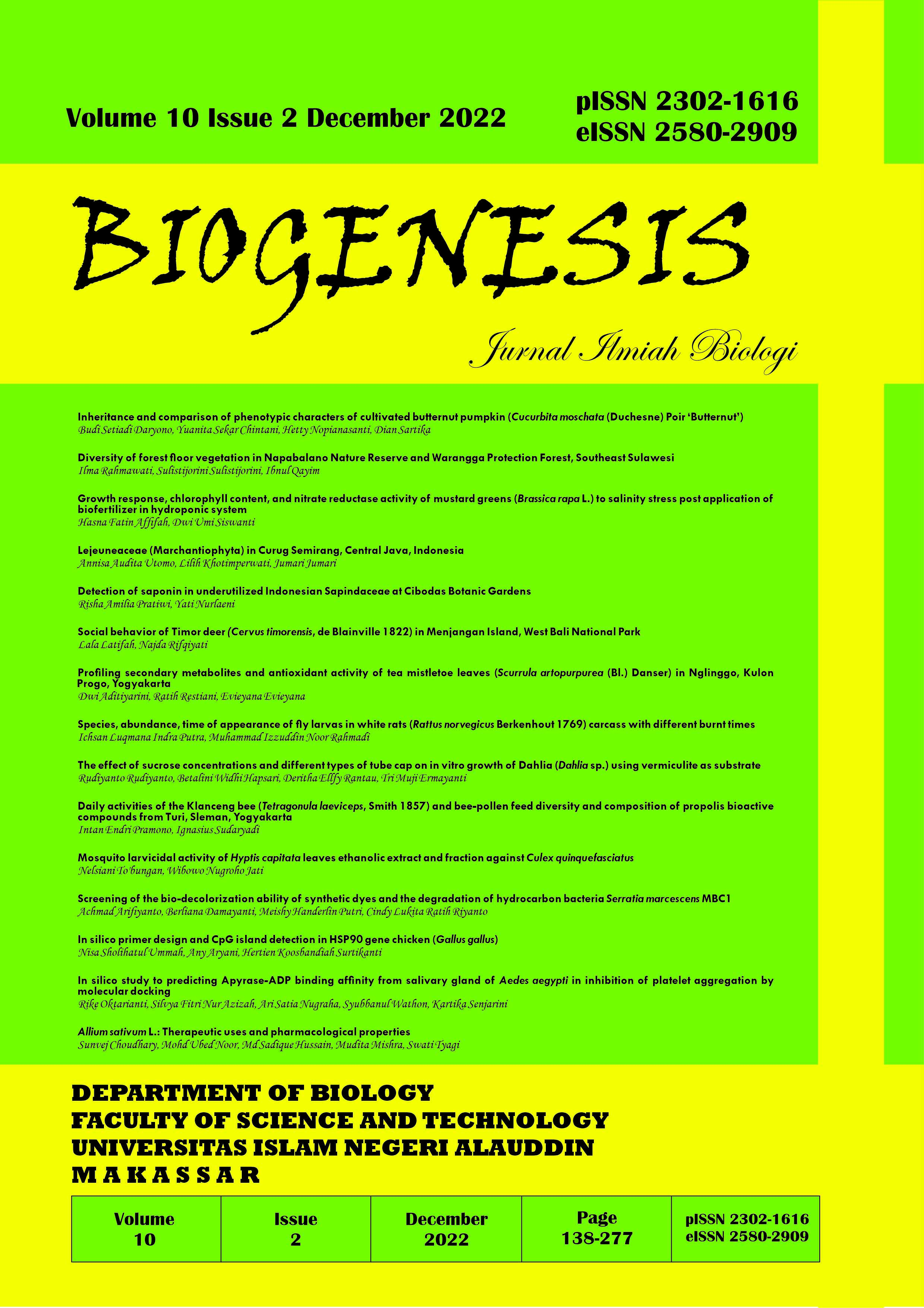Species, abundance, time of appearance of fly larvas in white rats (Rattus norvegicus Berkenhout 1769) carcass with different burnt times
Abstract
The use of insects in determining PMI is still little. The flies during the period of laying eggs and forming larvae can estimate the time of death. This study aims to determine the type, abundance, and time of appearance of fly larvae on white rat carcasses that were treated with burning. The experiment was conducted on 12 female white rats of the wistar strain, aged 2-3 months, healthy, and weighing 150-200 g. The research was experimental which consisted of 4 treatments with 3 repetitions of each treatment. The treatment was given by first anesthetizing the rats using 10% ether, then dislocating the cervical spine. After being sacrificed, the rats were burned using stainless tongs over a fire with variations in burning time, namely A (10 minutes), B (20 minutes), and C (30 minutes). The carcasses of each treatment were placed in an open field with a distance of 2.5 meters between the carcasses. Observations were made for 5 days until the carcass underwent complete decomposition. Larvae were taken from each carcass using tweezers, then put into vials containing 70% alcohol. The larvae were then identified morphologically in the laboratory. There were types of fly larvae found in the burnt treated white rat carcasses, namely Sarcophaga argyrostoma and S. haemorrhoidalis, while the controls were Chrysomya albiceps, C. megacephala, and C. bezziana. S. argyrostoma was found with the highest abundance in the treatment (39.9 individuals), while C. albiceps was found in the control (346.2 individuals). The first fly larvae that appeared in the burning treatment were S. argyrostoma (31 hours) and those of the control C. megacephala (31 hours). The conclusion of this study is that the variation of combustion has or does not affect the type, abundance, and time of appearance of fly larvae on the carcass.
Copyright (c) 2022 Ichsan Luqmana Indra Putra, Muhammad Izzuddin Noor Rahmadi

This work is licensed under a Creative Commons Attribution 4.0 International License.
COPYRIGHT AND LICENSE STATEMENT
COPYRIGHT
Biogenesis: Jurnal Ilmiah Biologi is published under the terms of the Creative Commons Attribution license. Authors hold the copyright and retain publishing rights without restriction to their work. Users may read, download, copy, distribute, and print the work in any medium, provided the original work is properly cited.
LICENSE TO PUBLISH
1. License
The use of the article will be governed by the Creative Commons Attribution license as currently displayed on http://creativecommons.org/licenses/by/4.0.
2. Author’s Warranties
The author warrants that the article is original, written by stated author/s, has not been published before, contains no unlawful statements, does not infringe the rights of others, is subject to copyright that is vested exclusively in the author and free of any third party rights, and that any necessary written permissions to quote from other sources have been obtained by the author(s).
3. User Rights
Under the Creative Commons Attribution license, the users are free to download, reuse, reprint, modify, distribute and/or copy the content for any purpose, even commercially, as long as the original authors and source are cited. No permission is required from the authors or the publishers.
4. Co-Authorship
If the article was prepared jointly with other authors, the corresponding author warrants that he/she has been authorized by all co-authors, and agrees to inform his/her co-authors of the terms of this statement.
5. Miscellaneous
Biogenesis: Jurnal Ilmiah Biologi may conform the article to a style of punctuation, spelling, capitalization, and usage that it deems appropriate. The author acknowledges that the article may be published so that it will be publicly accessible and such access will be free of charge for the readers.


